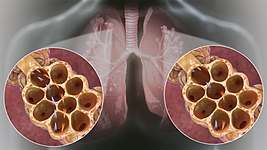Tachypnea
Tachypnea is a respiration rate greater than normal, resulting in abnormally rapid breathing.[1]
| Tachypnea | |
|---|---|
| Other names | Tachypnoea |
| Pronunciation |
|
| Specialty | Respirology |
In adult humans at rest, any respiratory rate between 12 and 20 breaths per minute is normal and tachypnea is indicated by a rate greater than 20 breaths per minute.[2] Children have significantly higher resting ventilatory rates, which decline rapidly during the first three years of life and then steadily until around 18 years. Tachypnea can be an early medical sign of pneumonia in children.
Distinction from other breathing terms

Different sources produce different classifications for breathing terms.
Some describe tachypnea as any rapid breathing. Hyperventilation is then described as increased ventilation of the alveoli (which can occur through increased rate or depth of breathing, or both) where there is a smaller rise in metabolic carbon dioxide relative to this increase in ventilation. Hyperpnea, on the other hand, is defined as breathing an increased volume of air, with or without an increase in respiration rate.[3]
Others give another classification: tachypnea is as any rapid breathing, hyperventilation is increased rate of breathing at rest, hyperpnea is an increase in breathing that is appropriately proportional to an increase in metabolic rate.[4]
A third paradigm is: tachypnea is abnormally rapid respiration (though some may argue this is inaccurate as breathing differs from respiration), hyperventilation is increased rate or depth of respiration to abnormal levels causing decreased levels of blood carbon dioxide and hyperpnea is any increase in breathing rate or depth that is not normal.[5]
Causes
Tachypnea may have physiological or pathological causes. Both of these categories would include large lists of individual causes. For example, physiological causes of tachypnea include exercise. Amongst pathophysiological causes, tachypnea can be a symptom of sepsis, compensation for diabetic ketoacidosis or other metabolic acidosis, pneumonia, pleural effusion, carbon monoxide poisoning, pulmonary embolism, asthma, COPD, laryngospasm, allergic reaction causing airway edema, foreign body aspiration, tracheobronchomalacia, congestive heart failure, anxiety states, or many other medical issues.
Etymology and pronunciation
The word tachypnea (/ˌtækɪpˈniːə/) uses combining forms of tachy- + -pnea, yielding "fast breathing". See pronunciation information at dyspnea.
See also
- Control of respiration
- Hypoventilation
- List of terms of lung size and activity
References
- https://www.ncbi.nlm.nih.gov/books/NBK470309/
- "tachypnea" at Dorland's Medical Dictionary
- https://www.ncbi.nlm.nih.gov/books/NBK470309/
- Martin, Elizabeth A (ed.) (2003). Oxford concise medical dictionary (6th ed. w. corrections & new cover) Oxford University Press. pp. 333–4. ISBN 0-19-860753-9
- "tachypnea". Dorland's Medical Dictionary for Health Consumers. Saunders, an imprint of Elsevier. 2007.